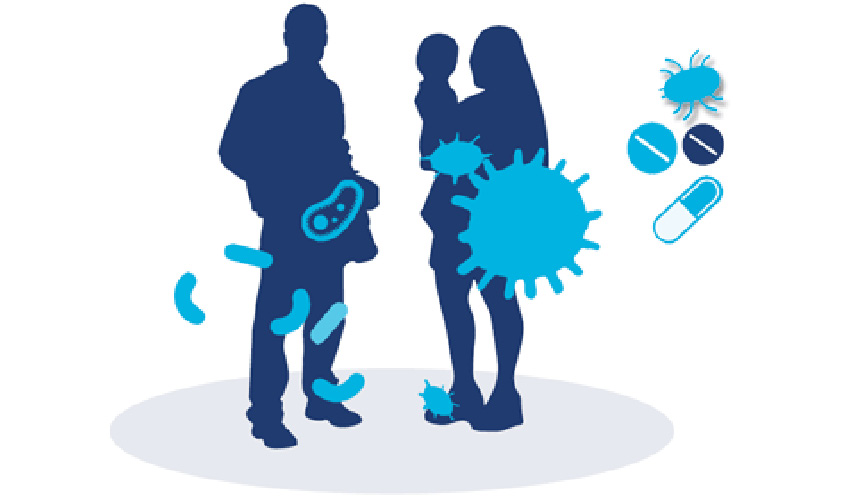India is one of the worst affected nations by antimicrobial resistance (AMR), a condition wherein bacteria and other microorganisms become resistant to antimicrobial medications used to cure the infections that these microorganisms cause. The overuse and misuse of these medicines is accelerating the spread of resistant bacteria, also known as “superbugs”. Experts have told The Sunday Guardian that owing to a poor infection control in Indian hospitals, the number of babies carrying antimicrobial resistant bacteria is growing at an alarming rate. More than 58,000 babies had died in 2013 as a result of AMR. Other factors like unsupervised dumping of pharmaceutical waste, excessive use of last resort antibiotics, and overuse of antibiotics on farm animals have only amplified the crisis. Common infections like urinary tract infection, gastrointestinal tract infection, and respiratory tract infection have become difficult to treat owing to growing resistance in bacteria causing them.
It is estimated that “resistant infection” claims seven lakh deaths across the globe annually. According to a recently published report in Aetna International, antibiotic consumption will increase by 99% in BRIC nations. According to another report, an estimated 10 million people will die by 2050 if the current situation goes unchecked.
“We have been using antimicrobial medicines for more than 60 years now. The bacteria and other microorganisms have had ample time to develop their defense. At the same time, we haven’t stopped relying on antibiotics for illnesses that might not have been caused by bacteria. Overuse of one of the last resort class of antibiotics, like Carbapenem, through its over-the-counter sale, is also magnifying the problem,” a senior resident doctor in a Delhi government hospital said.
Recent research in India by Swedish scientists has shown that antibiotic pollution from pharmaceutical production plants leads to the proliferation of resistant bacteria, hence fueling global AMR.
“Most of the world’s antibiotic drugs are manufactured in China and India. Due to cheap labour and capital costs, and lighter regulatory burden, China has become the world’s largest producer and exporter of Active Pharmaceutical Ingredients (API). Currently China exports up to 90% of all raw materials for antibiotics. This is problematic, since industrial release of antibiotics in substantial quantities provides an ideal ground for breeding of drug resistance bacteria. These superbugs then travel far through contaminated manure, water and air,” said K. Nanthakumar, Ph.D fellow, The Energy and Resources Institute (TERI). Nanthakumar added that resistant bacteria have been reported in waste water treatment plants in China and represent a major global threat, as they spread easily through international travel and trade.
“Tests on effluent from a treatment plant in Hyderabad, which receives wastewater from over 90 manufacturing plants, showed heavy concentrations of APIs. Main reason behind this the pressure to slash production price, which causes some factories to take shortcuts. This discourages proper management of antibiotic effluent, which ends up in rivers and groundwater surrounding manufacturing sites,” said Nanthakumar.
Experts noted that environmental regulation and its enforcement are currently left up to national regulators. However, compliance with “Good Manufacturing Practices” (GMP), a set of standards which are defined by the WHO and which are a mandatory requirement for accessing the European Union and the United States markets, do not include “environmental criteria” to properly look into the practice.
On the other hand, poultry farms are rearing not only chickens, but germs that have developed a tough defense against antibiotics. Nanthakumar noted that antibiotics are regularly fed to farm animals. This regular administration, albeit in low doses of drugs, wipes out weaker bacteria and leaves the field open for stronger strains. Simultaneously, manure is used as a fertiliser and is washed downstream into rivers and groundwater, thereby spreading the resistant genes to the wider bacterial community.
Multiple advisories have been issued by the Department of Animal Husbandry, Dairying and Fisheries to restrict the use of antibiotics as growth promoters in livestock. Farmers are also advised to follow good farming practices to prevent infection and stress in the flock. Yet, the advisories are not inviolable, and are often not adhered to.
“While these advisory are relevant in the context of curbing antibiotic use in livestock in India, these are not binding the farmer and are simply just guidelines. No such steps have been yet taken to limit antibiotic use in crops in India so far,” Dr Rajeshwari Sinha, programme officer, food safety and toxins programme, Centre for Science and Environment, said.

